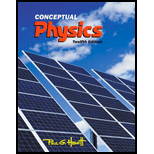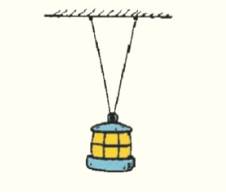
Conceptual Physics / MasteringPhysics (Book & Access Card)
12th Edition
ISBN: 9780321908605
Author: Paul G. Hewitt
Publisher: PEARSON
expand_more
expand_more
format_list_bulleted
Concept explainers
Textbook Question
Chapter 2, Problem 56RCQ
The rope supports a lantern that weighs 50 N. Is the tension in the rope less than, equal to, or grater than 50 N? Use the parallelogram rule to defend your answer.

Expert Solution & Answer
Want to see the full answer?
Check out a sample textbook solution
Students have asked these similar questions
Imagine you are out for a stroll on a sunny day when you encounter a lake. Unpolarized light from the sun is reflected off the lake into your eyes. However, you notice when you put on your vertically polarized sunglasses, the light reflected off the lake no longer reaches your eyes. What is the angle between the unpolarized light and the surface of the water, in degrees, measured from the horizontal? You may assume the index of refraction of air is nair=1 and the index of refraction of water is nwater=1.33 . Round your answer to three significant figures. Just enter the number, nothing else.
Deduce what overvoltage is like in reversible electrodes.
pls help on these
Chapter 2 Solutions
Conceptual Physics / MasteringPhysics (Book & Access Card)
Ch. 2 - What class of motion, natural or violent, did...Ch. 2 - What state of motion did Aristotle attribute to...Ch. 2 - What relationship between the Sun and Earth did...Ch. 2 - What did Galileo discover in his legendary...Ch. 2 - What did Galileo discover about moving bodies and...Ch. 2 - Is inertia the reason for moving objects...Ch. 2 - How does Newton's first law of motion relate to...Ch. 2 - What type of path does a moving object follow in...Ch. 2 - What is the net force on a cart that is pulled to...Ch. 2 - Why do we say that force is a vector quantity?
Ch. 2 - According to the parallelogram rule, what quantity...Ch. 2 - What is the resultant of a pair of 1-pound forces...Ch. 2 - Consider Nellie hanging at rest in Figure 2.11. If...Ch. 2 - Can force be expressed in units of pounds and also...Ch. 2 - What is the net force on an object that is pulled...Ch. 2 - What is the net force on a bag pulled down by...Ch. 2 - What does it mean to say something is in...Ch. 2 - State the equilibrium rule for forces in symbolic...Ch. 2 - Consider a book that weighs 15 N at rest on a flat...Ch. 2 - When you stand at rest on a bathroom scale, how...Ch. 2 - A bowling ball at rest is in equilibrium. Is the...Ch. 2 - What is the net force on an object in either...Ch. 2 - If you push on a crate with a force of 100 N and...Ch. 2 - What concept was not understood in the 16th...Ch. 2 - A bird sitting in a tree is traveling at 30 km/s...Ch. 2 - Prob. 26RCQCh. 2 - Prob. 27RCQCh. 2 - Prob. 28RCQCh. 2 - 29. The sketch shows a painter’s scaffold in...Ch. 2 - 30. A different scaffold that weighs 400 N...Ch. 2 - 31. The weights of Burl, Paul, and the scaffold...Ch. 2 - 32. Rank the net forces on the blocks from least...Ch. 2 - Different materials, A, B, C, and D, rest on a...Ch. 2 - Prob. 34RCQCh. 2 - As seen from above, a stubborn stump is pulled by...Ch. 2 - Nellie hangs motionless by one hand from a...Ch. 2 - Prob. 37RCQCh. 2 - Prob. 38RCQCh. 2 - Prob. 39RCQCh. 2 - Prob. 40RCQCh. 2 - Prob. 41RCQCh. 2 - Prob. 42RCQCh. 2 - Prob. 43RCQCh. 2 - Prob. 44RCQCh. 2 - Prob. 45RCQCh. 2 - Prob. 46RCQCh. 2 - Prob. 47RCQCh. 2 - Prob. 48RCQCh. 2 - Prob. 49RCQCh. 2 - Prob. 50RCQCh. 2 - Prob. 51RCQCh. 2 - Prob. 52RCQCh. 2 - Prob. 53RCQCh. 2 - Prob. 54RCQCh. 2 - Prob. 55RCQCh. 2 - The rope supports a lantern that weighs 50 N. Is...Ch. 2 - Prob. 57RCQCh. 2 - The rope of Exercise is repositioned as shown as...Ch. 2 - Prob. 59RCQCh. 2 - Prob. 60RCQCh. 2 - Prob. 61RCQCh. 2 - Prob. 62RCQCh. 2 - Prob. 63RCQCh. 2 - Harry the painter swings year after year from his...Ch. 2 - For the pulley system shown, what is the upper...Ch. 2 - Prob. 66RCQCh. 2 - Prob. 67RCQCh. 2 - Prob. 68RCQCh. 2 - Prob. 69RCQCh. 2 - Prob. 70RCQCh. 2 - Prob. 71RCQCh. 2 - Prob. 72RCQCh. 2 - Prob. 73RCQCh. 2 - Prob. 74RCQCh. 2 - Prob. 75RCQCh. 2 - Prob. 76RCQCh. 2 - Prob. 77RCQCh. 2 - Prob. 78RCQCh. 2 - Prob. 79RCQCh. 2 - Prob. 80RCQCh. 2 - Prob. 81RCQCh. 2 - Prob. 82RCQCh. 2 - Prob. 83RCQCh. 2 - Prob. 84RCQCh. 2 - Prob. 85RCQCh. 2 - Prob. 86RCQCh. 2 - Prob. 87RCQCh. 2 - Prob. 88RCQCh. 2 - Prob. 89RCQCh. 2 - Prob. 90RCQCh. 2 - Prob. 91RCQCh. 2 - Prob. 92RCQ
Knowledge Booster
Learn more about
Need a deep-dive on the concept behind this application? Look no further. Learn more about this topic, physics and related others by exploring similar questions and additional content below.Similar questions
- pls help on thesearrow_forward20. Two small conducting spheres are placed on top of insulating pads. The 3.7 × 10-10 C sphere is fixed whie the 3.0 × 107 C sphere, initially at rest, is free to move. The mass of each sphere is 0.09 kg. If the spheres are initially 0.10 m apart, how fast will the sphere be moving when they are 1.5 m apart?arrow_forwardpls help on allarrow_forward
- 19. Mount Everest, Earth's highest mountain above sea level, has a peak of 8849 m above sea level. Assume that sea level defines the height of Earth's surface. (re = 6.38 × 106 m, ME = 5.98 × 1024 kg, G = 6.67 × 10 -11 Nm²/kg²) a. Calculate the strength of Earth's gravitational field at a point at the peak of Mount Everest. b. What is the ratio of the strength of Earth's gravitational field at a point 644416m below the surface of the Earth to a point at the top of Mount Everest? C. A tourist watching the sunrise on top of Mount Everest observes a satellite orbiting Earth at an altitude 3580 km above his position. Determine the speed of the satellite.arrow_forwardpls help on allarrow_forwardpls help on allarrow_forward
- 6. As the distance between two charges decreases, the magnitude of the electric potential energy of the two-charge system: a) Always increases b) Always decreases c) Increases if the charges have the same sign, decreases if they have the opposite signs d) Increases if the charges have the opposite sign, decreases if they have the same sign 7. To analyze the motion of an elastic collision between two charged particles we use conservation of & a) Energy, Velocity b) Momentum, Force c) Mass, Momentum d) Energy, Momentum e) Kinetic Energy, Potential Energyarrow_forwardpls help on all asked questions kindlyarrow_forwardpls help on all asked questions kindlyarrow_forward
arrow_back_ios
SEE MORE QUESTIONS
arrow_forward_ios
Recommended textbooks for you
 Glencoe Physics: Principles and Problems, Student...PhysicsISBN:9780078807213Author:Paul W. ZitzewitzPublisher:Glencoe/McGraw-Hill
Glencoe Physics: Principles and Problems, Student...PhysicsISBN:9780078807213Author:Paul W. ZitzewitzPublisher:Glencoe/McGraw-Hill Principles of Physics: A Calculus-Based TextPhysicsISBN:9781133104261Author:Raymond A. Serway, John W. JewettPublisher:Cengage Learning
Principles of Physics: A Calculus-Based TextPhysicsISBN:9781133104261Author:Raymond A. Serway, John W. JewettPublisher:Cengage Learning University Physics Volume 1PhysicsISBN:9781938168277Author:William Moebs, Samuel J. Ling, Jeff SannyPublisher:OpenStax - Rice University
University Physics Volume 1PhysicsISBN:9781938168277Author:William Moebs, Samuel J. Ling, Jeff SannyPublisher:OpenStax - Rice University Physics for Scientists and Engineers with Modern ...PhysicsISBN:9781337553292Author:Raymond A. Serway, John W. JewettPublisher:Cengage Learning
Physics for Scientists and Engineers with Modern ...PhysicsISBN:9781337553292Author:Raymond A. Serway, John W. JewettPublisher:Cengage Learning Physics for Scientists and EngineersPhysicsISBN:9781337553278Author:Raymond A. Serway, John W. JewettPublisher:Cengage Learning
Physics for Scientists and EngineersPhysicsISBN:9781337553278Author:Raymond A. Serway, John W. JewettPublisher:Cengage Learning Physics for Scientists and Engineers: Foundations...PhysicsISBN:9781133939146Author:Katz, Debora M.Publisher:Cengage Learning
Physics for Scientists and Engineers: Foundations...PhysicsISBN:9781133939146Author:Katz, Debora M.Publisher:Cengage Learning

Glencoe Physics: Principles and Problems, Student...
Physics
ISBN:9780078807213
Author:Paul W. Zitzewitz
Publisher:Glencoe/McGraw-Hill

Principles of Physics: A Calculus-Based Text
Physics
ISBN:9781133104261
Author:Raymond A. Serway, John W. Jewett
Publisher:Cengage Learning

University Physics Volume 1
Physics
ISBN:9781938168277
Author:William Moebs, Samuel J. Ling, Jeff Sanny
Publisher:OpenStax - Rice University

Physics for Scientists and Engineers with Modern ...
Physics
ISBN:9781337553292
Author:Raymond A. Serway, John W. Jewett
Publisher:Cengage Learning

Physics for Scientists and Engineers
Physics
ISBN:9781337553278
Author:Raymond A. Serway, John W. Jewett
Publisher:Cengage Learning

Physics for Scientists and Engineers: Foundations...
Physics
ISBN:9781133939146
Author:Katz, Debora M.
Publisher:Cengage Learning
Newton's First Law of Motion: Mass and Inertia; Author: Professor Dave explains;https://www.youtube.com/watch?v=1XSyyjcEHo0;License: Standard YouTube License, CC-BY